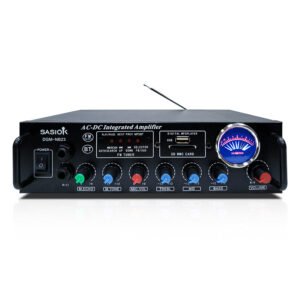The audio amplifier, a cornerstone of modern sound reproduction, has undergone transformation changes since its inception. From bulky vacuum tubes to sleek digital modules, its evolution reflects a century of engineering breakthroughs and shifting consumer demands.
The Vacuum Tube Era (1920s–1950s)
The story begins with Lee De Forest’s 1906 invention of the triode vacuum tube, which enabled the first practical audio amplifiers. By the 1920s, tube-based amplifiers powered early radio broadcasts and phonograph systems. These Class A amplifiers produced warm, natural sound but suffered from inefficiency, generating substantial heat and requiring frequent maintenance. Their high cost and fragility limited use to professional settings until the 1950s, when iconic Hi-Fi systems like the Williamson amplifier brought tube technology into affluent households.
Transistor Revolution (1950s–1970s)
A paradigm shift occurred in 1947 with Bell Labs’ transistor invention. By the late 1950s, germanium transistors enabled portable amplifiers, followed by silicon transistors in the 1960s that offered greater reliability. Solid-state amplifiers (Classes AB and B) dominated the market by the 1970s, praised for their compact size, energy efficiency, and crisp detail. However, early models faced criticism for “transistor harshness” – a sterile sound quality compared to tubes. This era saw the rise of legendary brands like Pioneer and Marantz, democratizing high-fidelity audio.

Integrated Circuits & Digital Age (1980s–2000s)
The 1980s introduced operational amplifiers (op-amps) on integrated circuits, allowing complex signal processing in devices as small as Walkmans. The 1990s witnessed two key developments: Class D amplifiers using pulse-width modulation (PWM) for 90%+ efficiency, and the advent of digital signal processing (DSP). While purists debated “analog vs. digital,” technologies like THX certification and Dolby Surround redefined home theater experiences. Yamaha’s DSP-1 (1986) exemplified this convergence, blending amplification with room calibration.
Modern Innovations (2010s–Present)
Today’s amplifiers prioritize connectivity and intelligence. Bluetooth-enabled chip sets like Qualcomm’s aptX HD support lossless wireless streaming, while AI-driven systems (e.g., Dirac Live) optimize sound in real-time. GaN (gallium nitride) transistors and hybrid designs bridge the gap between tube warmth and digital precision. Environmental concerns drive development of ultra-efficient designs, with companies like NAD Electronics pioneering eco-conscious amplification. Meanwhile, niche markets sustain tube amplifier production, celebrating vintage analog charm.
Conclusion
Audio amplification has evolved from solving basic signal reinforcement to delivering nuanced, personalized listening experiences. Each technological leap – tubes, transistors, ICs, and digital processing – addressed the dual demands of fidelity and practicality. As immersive audio formats and smart ecosystems proliferate, amplifiers continue to adapt, ensuring their role as both workhorses and artists in humanity’s ongoing dialogue with sound.








